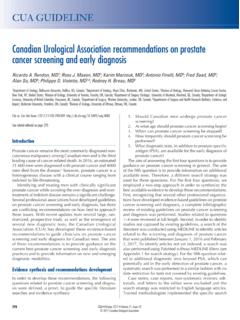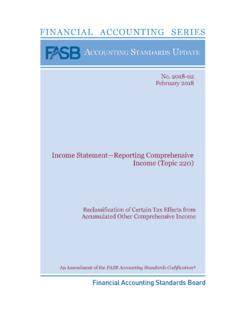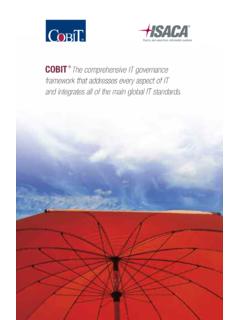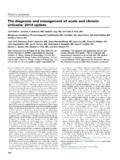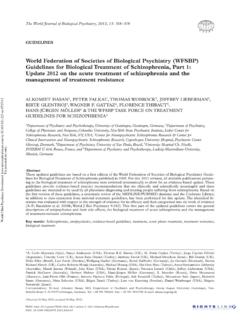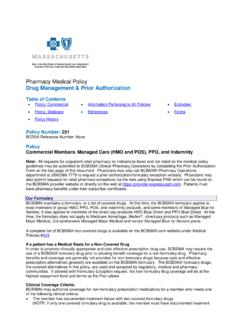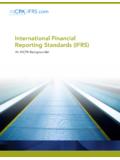Transcription of CUA guideline on the evaluation and medical management …
1 CUAJ November-December 2016 Volume 10, Issues 11-12 2016 Canadian Urological AssociationE347 Marie Dion, MD;1 Ghada Ankawi, MD;2 Ben Chew, MD;3 Ryan Paterson, MD;3 Nabil Sultan, MD;2 Patti Hoddinott, MD;1 Hassan Razvi, MD11 Division of Urology, Schulich School of Medicine and Dentistry, Western University, London, ON, Canada; 2 Division of Nephrology, Schulich School of Medicine and Dentistry, Western University, London, ON, Canada; 3 Department of Urological Sciences, University of British Columbia, Vancouver, BC, CanadaCite as: Can Urol Assoc J 2016;10(11-12):E347-58. online November 10, technological advances in the surgical manage-ment of upper tract urinary stone disease that have signifi-cantly reduced patient morbidity and recovery time, new stone formation and recurrence remain significant health issues. Data from the National Health and Nutrition Examination Survey (NHANES) published in 2012 noted a kidney stone prevalence of in men and among Comparing these results to a similar survey con-ducted between 1976 and 1994, the overall prevalence of stone disease in the population has increased from to An increase in stone formation, particularly among women, has also been observed such that the male.
2 Female ratio appears to be ,4 Recent evidence also sug-gests there may be an increase in the incidence of certain stone compositions, such as uric acid, a type of stone clearly linked to both dietary and metabolic risk rates after an initial symptomatic stone event are reported to be from 30 50% within 10 years of first ,7 Patients are, therefore, generally motivated to explore prevention Studies have shown, how-ever, that patients are more willing to undergo metabolic evaluation compared to physicians willingness to further investigate Epidemiological data from the show that only 7% of patients with a high risk of recurrent stone disease undergo metabolic evaluation by any odds of undergoing metabolic evaluation were and times higher if patients were seen by a nephrologist or urologist, respectively. Bensaleh et al noted that 81% of patients interviewed would prefer to take a prophylactic medication than undergo another stone episode, and 92% of respondents preferred medication to undergoing summary, the vast majority of stone patients would benefit from metabolic evaluation , but are not being economic burden of recurrent stone disease is also sig-nificant.
3 Estimates of direct costs to care for and treat patients with stones and the indirect costs related to lost work time exceed $5 billion ,11 The observed increases in health-care expenditures associated with nephrolithiasis are likely due to the increasing prevalence12 and procedure-related costs, despite a shift towards outpatient treatment, shorter length of hospital stay, and more minimally invasive Given the rising rates of obesity and diabetes and their association with stone formation, the cost of managing stone disease is expected to increase to billion dollars yearly in the by Clearly, the need for stone prevention in those at risk will continue to have an important 2010, the Canadian Urological Association (CUA) guidelines Committee commissioned the development of a clinical practice guideline on the evaluation and medi-cal management of patients with upper tract urolithiasis.
4 The aims of the guideline were to help clinicians identify patients at heightened risk of stone recurrence, to outline the required investigations to assess these patients, and to pro-vide up-to-date advice on dietary and medical interventions of proven benefit in the Canadian context. In accordance with the CUA s policy of reviewing the content of guidelines every five years, this topic was felt to be ready for revision to reflect new advances in the preventative management of patients with renal stones. It should be noted that this guide-line addresses the evaluation and medical prophylaxis of upper tract stones and not stones forming within the bladder. Literature review The content included in this document was obtained from a review of the English language literature. management rec-ommendations were based, whenever possible, on the most current literature since the last CUA guideline was published in 2010.
5 A PubMed search was conducted encompassing the period from January 1, 2005 to July 1, 2015 to include the following terms in either the title or abstract: nephro-lithiasis, urolithiasis, kidney stone, renal stone, and CUA guideline on the evaluation and medical management of the kidney stone patient 2016 update guidelineCUAJ November-December 2016 Volume 10, Issues 11-12E348dion et al. urinary stone. In total, 4603 article titles were reviewed and 698 were identified as potentially relevant for inclusion in the literature assessment for this guideline . In addition, all references from recently published guidelines were assessed and relevant studies were included in our literature review. Studies were evaluated and recommendations made based on Oxford levels of evidence and grades of recom-mendation as per the CUA s guidelines Committee s direc-tive. guideline statements with management recommenda-tions were developed based on the highest level of for metabolic evaluation It is generally accepted that even the first time stone-former, without any identifiable risk factors for recurrent stone for-mation, should undergo a limitedmetabolic evaluation to rule out potential systemic disorders, such as hyperpara-thyroidism and renal dysfunction.
6 This evaluation should include a urinalysis culture, serum electrolytes (Na, K, Cl, HCO3), serum Ca, and serum creatinine (Level of Evidence 4, Grade C Recommendation).An in-depth metabolic investigation may be considered for any patient who is interested and willing to participate in the endeavor to collect and analyze a 24-hour urine study and have blood work drawn, and is willing to alter his/her diet or begin pharmacotherapy. There are, however, patient populations with clearly known risk factors where an in-depth metabolic investigation is highly recommended (Level of Evidence 3, Grade C Recommendation):14-20 Children (<18 years of age) Bilateral or multiple stones Recurrent stones (having had two or more kidney stone episodes in the past) Non-calcium stones ( , uric acid, cystine) Pure calcium phosphate stones Any complicated stone episode that resulted in a severe (if even temporary) acute kidney injury, sepsis, hospitalization, or complicated hospital admission Any stone requiring percutaneous nephrolithotomy treatment Stones in the setting of a solitary (anatomical or func-tional) kidney Patients with renal insufficiency History of kidney stones and systemic disease that increases the risk of kidney stones ( , gout, osteo-porosis, bowel disorders, hyperparathyroidism, renal tubular acidosis, etc.)
7 Occupation where public safety is at risk ( , pilots, air traffic controller, police officer, military person-nel, firemen)Due to the infectious nature and cause of struvite stones, routine metabolic evaluation of patients with struvite stones is not usually recommended; however, routine urine culture and radiological investigations are necessary in this patient population. In-depth evaluationFor those patients where an in-depth evaluation is indicated, the workup should include serum and 24-hour urine tests, as well as a thorough dietary history. These tests should include:a) Serum: Creatinine, sodium, potassium, chloride, calcium, albumin, uric acid, bicarbonate Parathyroid hormone (PTH) level if serum calcium is high normal or abnormally elevated Vitamin D if low normal serum calcium or ele-vated serum PTHb) 24-hour urine collection: Volume, creatinine, calcium, sodium, potassium, oxalate, citrate, uric acid, magnesium Cystine if suspect cystine stone or if the stone analysis is cystinec) Spot urine.
8 Urine pH Urinalysis Specific gravityNumber of 24-hour urine collectionsThere is some controversy regarding the number of 24-hour urine collections necessary to investigate ,22 Recent data suggests that up to of patients had their clinical management changed by an abnormality that was identified only when two samples were ,24It is currently rec-ommended that two 24-hour urine collections be obtained in order to correctly identify metabolic abnormalities. The benefit of two collections should be balanced, however, by the practicality and importance of obtaining at least one collection (Level of Evidence 3, Grade C Recommendation).Importance of stone analysisIdentification of stone composition will aid in determining prevention and directing surgical options for future stones. Furthermore, identification of struvite, ammonium urate, uric acid, calcium phosphate, or cystine stones would alter whether or not 24-hour urine tests are required.
9 Efforts should, therefore, be made to have patients collect stones they have passed or if stones are removed at the time of surgical intervention, they should be submitted for analysis (Level of Evidence 3, Grade C Recommendation). If a patient continues to form new stones, it is worthwhile to repeat a stone analysis of the patient s subsequent stones. Stone composition changed in of patients over time. Patients interchanged between calcium oxalate and calcium CUAJ November-December 2016 Volume 10, Issues 11-12E349 Kidney stone guideline updatephosphate stones, and some uric acid stone-formers became calcium oxalate dietary measuresBasic dietary and fluid intake advice has been shown to be effective in reducing stone recurrence rates and seems warranted for even the first-time stone-former without iden-tifiable risk factors. The stone clinic effect first described by Hosking et al is a well-known phenomenon whereby counselling on appropriate fluid intake to avoid dehydra-tion and dietary excesses can significantly reduce stone involvement of a registered dietician, if available in the counselling of patients with recurrent renal stones, should be incorporated into the management of these patients.
10 In a retrospective review of 137 kidney stone patients with abnormalities on their 24-hour urine collection, after assess-ment and specific recommendations were made by a regis-tered dietician, significant improvements were noted in urine volume, sodium, calcium, uric acid, citrate, and with a registered dietician is strongly suggested where there is a history of compromised nutritional status, complex medical situations, patients with deficient nutrition knowledge, dietary risk cannot be completely assessed by the urologist, or for anyone who needs assistance imple-menting dietary ,29 Evidence suggests that patients who received specific dietary recommenda-tions based on a comprehensive evaluation had fewer stone recurrences over three years than those who only received general dietary majority of studies evaluating the effect of dietary measures on stone prevention are based on retrospective cohort analyses.
